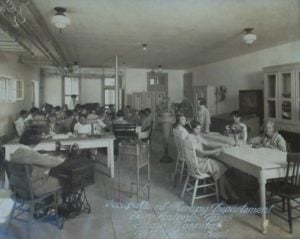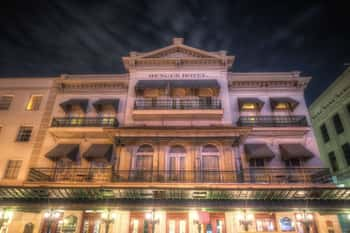
Asylums have a well established history for ghostly, unexplainable occurrences and throughout the county, throughout the world. The horrific "treatments" that the patients of these institutions were subjected to is often thought to be the source behind this paranormal phenomenon. The history of the San Antonio State Hospital (originally called the Southwestern Insane Asylum), is one that is especially hard to grasp. It's a history filled with hardship, corruption, scandal and death (much like our nation's capital).
The San Antonio State Hospital (SASH) is still in operation today at the same location of its conception at 6711 S New Braunfels Avenue. While there are new buildings in place of the original structures, the hospital is not associated with the nearby, often-photographed ruins that have lit up the Internet in recent years. The four abandoned buildings near the site of the hospital actually belonged to the Bexar County Juvenile Home for Boys.
The SASH is one of ten state mental health facilities operated by the Texas Department of State Health Services (DSHS). Those who are admitted may have done so voluntarily, but more often than not the choice was not theirs to make. And in the many years following their deaths, the Hospital continues to play host to the ghosts of both the mentally ill as well as the people who were wrongfully checked in.
The first center established in Texas for those suffering from mental illness was the Texas State Lunatic Asylum (later assigned a more, shall we say, politically correct misnomer: the Austin State Hospital), though the site did not begin operating till May of the year 1961, when Dr. Beriah Graham admitted the inaugural 12 patients.
San Antonio's first center for the mentally ill was the Southwestern Insane Asylum (San Antonio State Hospital) and was established on April 6, 1892. The hospital was built on 640 acres, and had the capacity to hold up to 500 patients. The hospital was essentially a self-sufficient village with crops, livestock and a lake for fishing.
In the year of 1910, the hospital was given a hundred thousand dollars for expansion, and by 1912 they were able to accommodate up to 1,140 patients. In 1925, the state asylums decided to drop terms such as "insane" and "lunatic" from their names, and so, the Southwestern Insane Asylum officially became known as the San Antonio State Hospital. The following year the hospital's capacity averaged around 2,103, which was one of the few years that the hospital did not exceed more patients to beds than they actually had in their disposal.

After expansion in the 1920s, the original Southwestern Insane Asylum (now the San Antonio State Hospital) continued to grow ever larger. Even so, the hospital almost always surpassed capacity.
The Superintendent of SASH recognized that the hospital was at its breaking point, and that it was in desperate need of additional facilities. Conditions only worsened over the next few years, with reports of the hospital overcrowding again in 1934. Subsequently, construction of five new buildings commenced on the property and were eventually completed by the year of 1939. The hospital was now able to administer modern treatments for the patients, but just a year later the hospital became overcrowded yet again, surpassing capacity at 2,308. Patients were being turned away at the door. Patience who were legitimately in need of aid, as well as those who suffered more “undiagnosed” diseases like seizures. (Seizures were often deemed to be the sign of an overwrought, mentally unstable individual).
Over 700 people were put in jails across the state during this period.
Racial desegregation began at the hospital in 1964, as the first African-American patient was admitted. Also in 1964, case worker, Helen Cloud Austin, became the first African-American to become a member of the hospital’s elite staff. There was further progress in the 1970s with the San Antonio State Hospital (SASH) becoming accredited by the Joint Commission on Accreditation of Hospitals; outreach clinics becoming established in other nearby towns, (which helped in reducing the hospitals population to 1,836); and with renovations and additions that modernized the hospital.
The halls of this institution are littered with the discarded memories of former patients. The hospital officials may want to forget the "long train of abuses," but the souls of these departed patients will never let that happened. These restless spirits roam the grounds trying their best to warn current patients, fearful they may meet a similar fate. Below are just a few tales from the past.

In 1910, the alleged "insane" Browne sued for having been incarcerated at the SASH.
It was reported on March 6, 1910, that a man was held at the asylum for twelve years. This case was one of those "stranger than fiction" stories. William I. Browne was released from the Southwestern Insane Asylum (SASH), on orders by County Judge Phil Shook based on the illegal restraint of liberty. After spending over a decade in the asylum, William Browne, was once again free to live his life.
Twelve years prior, Browne, alleged to be a heavy-weight drinker, was consigned to the asylum based on the recommendation of one Dr. Miguel Braragon. Only, Dr. Braragon’s diagnosis and condemnation of Browne was done without an adequate examination and the proper process of law. For over a decade William fought for his freedom, only to be selfishly blocked by those (his siblings) who were interested in keeping him locked away.
Finally, in the year 1910, William Browne was granted a hearing to determine if he was now “sane.” As was done in the day, William was asked a series of perplexing questions. Thankfully, Browne was successful in answering all of inquiries to the judge's satisfaction—he thus was legally restored as a sane man. A relief on his part, no doubt, since he’d been locked away in the asylum for a dozen years.
This is where the story gets a little strange, and it’s necessary for us to rewind a bit—twelve years—to not longer after William was put in the Southwestern Insane Asylum in the first place. It was no long after this time that William’s father died. In Browne, Sr.’s will, William was given a share in a very valuable deal of property. However, his brothers, Albert and James I. Browne, and sister Mrs. Caroline de San Roman took control of his share and also other property that William had himself owned. The value of these holdings grew steadily over the next decade, while William Browne continued to sit and wait for a possible release from the Insane Asylum. The share holdings would have made William a fantastically wealthy man. It was only after Judge Phil Shook ordered William’s release from the asylum in 1910 that he realized that he should have accumulated a whole lot of money from the holdings and land ownership. He turned right around and sued those responsible for his incarceration—it didn’t help that he was now at odds with his siblings, who had purposely stolen the bequeathing from their father’s will and left him to dry.
There is no evidence to suggest whether William Browne won or lost his particular trial.
There is, however, other evidence as to how his family felt about about poor William—and that “feeling” was not warm or loving at all.
On June 17, 1916, William's body was found floating on the Mexican side of the Rio Grande. According to newspaper accounts, he had been murdered near the The Brownsville & Matamoros International Bridge. Coincidently, (or not), his brother Albert was the Mayor of Brownsville, Texas, at the time of William’s death.
While we will never know the particulars of William Browne’s death, it’s safe to say that his siblings were once again in control of his finances. This time it was for good.
Another man from Brownsville, Texas, who according to newspaper accounts was a sane man, was Stephen S. Aldridge, who happened to be a veteran of World War II. Aldridge spent three months in the San Antonio State Hospital in 1944. This man who fought in WWII, said of the hospital, "Never again do I want to experience the sight of such cruelties." Aldridge went on to explain, "I've seen attendants walk up and slap an inmate down on an impulse—for no reason at all. I've seen men stomped, and I've seen them force insane people to work."
A horrifying description that does little to paint the State Hospital in a good light during the 1940s.

A rare photo of a therapy session at SASH, 1920s.
Aldridge was discharged from the Army on May 11, 1942, because of a bad heart. He also had a nervous condition that needed to be attended to. When he returned to Brownsville, he tried to be admitted to the Veteran's Hospital, but the government had yet to make necessary provisions for veterans of WWII. Aldridge's nervous condition was only getting worse, so he committed himself to the SASH as an ultimate last resort.
"Personally, they didn't treat me mean," Aldridge said, before adding, "But the helpless and really insane were treated in a brutal manner. Nevertheless my turn came: One day some of the attendants tried to force me to mop up the floor. I refused. Not because I didn't want to work—it was because I was afraid of my heart."
Upon Aldridge's refusal to mop the floor, one of the attendants directed profanity at him. Aldridge, not willing to take that sort of verbal abuse, responded with similar language. He also added that they would have had to stomp his guts out to get him to work for them.
The attendants then cornered him. He lunged for a chair, grabbing and positioning it before him to protect himself from their attack. But, luckily, just then a doctor walked by. Aldridge called out to him for help. The doctor then hollered at the attendants, "Lay off that boy, he's not crazy."
Because apparently there an unspoken code that only the “crazies” could be mistreated.
(Disclaimer: the San Antonio State Hospital does not treat its patients like this any longer).
A number of Valley people died under mysterious circumstances at the San Antonio State Hospital, ranging from teenagers to the elderly.
One of these poor souls was Chuauhtemco "Chino" Garcia, just nineteen-years-old, but a big boy, weighing in between 180-190 pounds. He was also a smart kid, who was attending the University of Texas just before he was admitted into the San Antonio State Hospital. At the time Chino entered the hospital he was not physically ill, but a mere three days later he died. No cause of death was given in the report or his obituary.
Another youth by the name of Raul G. Chapa entered the hospital after suffering a nervous breakdown, and was found dead eleven days after he was admitted to the institution.
Raul's physician, Dr. G. S. Bremont, said of his passing, "I was surprised when I learned Raul Chapa was dead." Dr. Bremont elaborated by saying that Raul's mental illness condition would not have caused his death. He added, "Chapa was not a violent mental case. He suffered from maniacal-depressive type of mental-illness. He would have raving spells, following which he would become depressive. But he was physically healthy."

Countless newspaper accounts have reported on the horrific conditions at the San Antonio State Hospital since its construction--and for many years, those who were sent there were deemed to be "on the march of death." Today, still, those who died continue to haunt the property.
As I mentioned, there were also speciousness deaths of the elderly. Rose Fisher Harrison, referred to as a little old lady and a helpless invalid in newspaper accounts, had lost control of her limbs and could no longer take care of herself. So, she was brought to the hospital. Before she was admitted, a doctor made a comment to police, saying of Mrs. Harrison, "She's so old—we want the young ones."
Seven months later, Mrs. Harrison was dead.
Yet, another death that got mentioned in newspaper headlines was that of a 75-year-old man who was beaten, starved and dehydrated so severely, he lost an astonishing 30 pounds in only 15 days.
These stories told by and revealed by the press ultimately spurred Coke R. Stevenson to open an investigation into the hospital's actions. Weaver H. Baker (Chairman of the State Board of Control) was put in charge of the investigation, though little was ever actually done to help the people held at the San Antonio State Hospital.
In 1979, a 300-pound man named Patrick O'Brien (a 36-year-old recluse), told police after his arrest that he was the son of Hitler and the father of the Dallas Cowboy cheerleaders. O'Brien was arrested by the police for murdering his parents, William and Mary, who were reportedly stabbed so many times that they looked like they had each been blasted with a shotgun. William's body also had third-degree burns, as his son Patrick had attempted to electrocute him prior to the stabbing.
Patrick O'Brien had been institutionalized at the San Antonio State Hospital for a total of eight times from 1966-1975. Not once did he stay for longer than a period of ninety days, which begs the question: if the Hospital had kept Patrick institutionalized, would he have been driven by some unseen force to brutally stab his mother and father?
After murdering his parents in 1979, Hitler’s Son (more commonly known as Patrick O’Brien, who was not in fact Hitler’s son) was once again checked into the State Hospital.
Robert Pugh, the head of the Bexar County Mental Health Department, said of Patrick, "He is a very, very sick man. He should have never been out on the streets. He has a history of Violence. He was close to a Ph.D. in mathematics. He is a brilliant man, but a terribly sick man." (Um, duh!)
With a history as murky as the San Antonio State Hospital's, reports of haunting are undoubtedly believable.
One person who used to work at the hospital claims that the grounds are madly haunted, which makes complete sense. It would be weird if there wasn’t a single ghostly tale at the property.
A current employee said of the SASH, "I work there. Been there for 8 years. It's a scary place."
Another current employee added, "There's Death around... We hear and see things.”
For the most part, it seems that many of the employees of the Hospital are perturbed by the paranormal events, but aren’t willing to
Apparently communication hasn't gotten any better at the SASH over the years. Their online reviews are quite eerie.
A woman left a comment on their facebook page, saying the her beloved brother was is in the facility, and that she was not able to get a hold of him.
A concerned mother commented. "The staff is rude and unprofessional. They provoke children, then once they act up by talking back... It's enough for them to throw the child into a restraining mechanical chair." She added, "My daughter has been treated worse than an animal."
Just before Christmas of 2014, the hospital announced that they were unable to admit any more patients. The root of this was caused by a shortage of nurses, as explained by Carrie Williams, a spokeswoman for the Texas Department of State Health Services (which oversees the San Antonio State hospital): “We have a total of 83 nurse positions at the hospital (SASH), and 12 of those are vacant, plus we have several nurses out for an extended period of time due to medical reasons.” she then added. “We’ve had several nurses recently leave for other positions in the community.”
Two years prior to the nursing shortage, there was another sign of trouble, when a lawsuit was brought by a disability group, rightfully arguing that mentally ill prisoners were sitting in jail rather then being placed at SASH.
The CEO of the Center for Health Care Services, Leon Evans, said of the problem at SASH, “We’ve been underfunded in behavioral services in Texas so long, and we don’t think outside the box.” Evans goes on to say, “Our funding is in silos, and we’ve got people taking up beds at the state hospital that don’t belong there, people with Alzheimer’s and closed-head injuries, taking up civil beds. And we have no community-based alternatives, no step-down units, no residential treatment facilities.”
Judge Oscar Kazen who presides over Bexar County's Mental Health Court, commented, “It’s only in the last couple of years that we’ve been able to convince University (Hospital) to begin taking unfunded involuntary patients". He adds “We are now down to a sinking lifeboat. Even if you repair it, it’s still a damn lifeboat.”
First - we cannot stress this enough - do not trespass. If you do, you're dumb and you probably deserved to be arrested. To find the hospital, you can use the map we provided. But, once again, don't do anything dumb like try to trespass on private property.

San Antonio's most haunted Church

San Antonio's most haunted Hotel

San Antonio's most famous haunted landmark